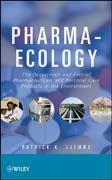
Pharma-ecology: the occurrence and fate of pharmaceuticals and personal care products in the environment
Jjemba, Patrick K.
This book provides researchers and scientists important background data on the environmental impacts of pharmaceuticals and personal care products (PPCPs).It highlights the biological effects of pharmaceutical compounds under clinical settings and discusses their pollution, fate, and transport. It stresses some of the ecotoxicological aspects of PPCPs and includes a chapter that links clinical pharmacokinetics/pharmacodynamics (PK/PD) with the kinetics of PPCPs in the environment. This is a key reference for engineers, toxicologists, ecologists, microbiologists, regulatory personnel, and pharmaceutical professionals who develop PPCPs. INDICE: Chapter 1: PPCP usage in relation to the environment and modes of action. 1.1. Personal care products. 1.1.1 Fragrances and musks. 1.1.2 Detergents. 1.1.3 Disinfectants. 1.2. Pharmaceutical compounds. 1.2.1 Antihypertensive and cardiovascular. 1.2.2. Anxiolytic sedatives, hypnotics and antipsychotics. 1.2.3 Analgesics and anti-inflammatory drugs. 1.2.4. Antimicrobial compounds. 1.2.4.1 Cell wall synthesis inhibiting antibiotics. 1.2.4.2 Inhibitors of protein synthesis. 1.2.4.3 Nucleic acid synthesis inhibitors. 1.2.4.4 Antagonism to metabolic processes. 1.2.4.5 Antibiotics that disrupt membrane integrity.1.2.4.6 Other antimicrobials. 1.2.5. Gastrointestinal drugs. 1.2.6. Anti-diabetic drugs. 1.2.7. Diuretics and electrolytes. 1.2.8. Thyroid system medication. 1.2.9. Respiratory drugs. 1.2.10. Oral contraceptive and reproductive therapeutics. 1.2.11. Biophosphonates and other skeletal ailment drugs. 1.2.12. Steroids. 1.2.13. Hematologic drugs. 1.2.14. Nutritional. 1.2.15. Triptans. 1.2.16. Anesthetics. 1.2.17 Antineoplast and immunosuppressants. Chapter 2: Detection and Occurrence of PPCPs in the environment. 2.1 Detection of PPCPs in the environment. 2.1.1. Detection using instrumentation. 2.1.2. Detection using bioassays. 2.2 Occurrence of PPCPs in various environments. 2.2.1. Aquatic systems. 2.2.1.1. PPCPs in wastewater. 2.2.1.2. PPCPs in surface water. 2.2.1.3. PPCPs in groundwater. 2.2.1.4. PPCPs in potable water. 2.2.2. Occurrence of PPCPsin sediments. 2.2.3. PPCP occurrence in soil. 2.2.4. Aerial environments. 2.3Excretion as a driver of pharmaceutical occurrence in the environment. Chapter 3: Ecopharmacokinetics and ecopharmacodynamics. 3.1 Overview of pharmacokinetics and pharmacodynamics. 3.1.1. PPCP sorption and bioavailability in the environment. 3.1.2. Compound half-life and clearance. 3.2 Degradation of PPCPs inthe environment. 3.2.1 Degradation of antibiotics in the environment. 3.2.1.1Quinolone compounds. 3.2.1.2 Fate of ??lactams and cephalosporins. 3.2.1.3 Degradation of tetracyclines. 3.2.1.4 Degradation of macrolides. 3.2.1.5 Fate ofother important groups of antibiotics. 3.2.2 Degradation of analgesics and anti-inflammatory drugs. 3.2.3 Degradation of estrogens and other reproductive hormones in the environment. 3.2.4 Degradation of other important pharmaceuticals. 3.2.5 Degradation of surfactants. 3.3 Role of physicochemical factors in the fate of PPCPs in the environment. 3.3.1 Molecular size as an attribute to absorption and persistence. 3.3.2 Solubility and hydrolysis. 3.3.3 Effects of chemical dissociation, partitioning and lipophilicity on PPCP degradability. 3.3.4 Effects of moisture and oxygen in the fate of PPCPs in the environment. 3.3.5 Effects of temperature in PPCP dynamics and degradation in the environment. 3.3.5 Other factors that determine PPCP fate and persistence in the environment. 3.3.5.1 Effect of the presence of other compounds. 3.3.5.2 Photolysis of PPCPs. Chapter 4: Ecotoxicity of PPCPs. 4.1 Conventional assessment of the risk. 4.2 Ecological impact of PPCPs on microorganisms and microbial processes. 4.2.1. Antibiotic Resistance. 4.2.1.1 Acquisition of antibiotic resistance. 4.2.1.2 Mechanisms of antibiotic resistance. 4.2.2 Biogeochemical perturbations. 4.3 Effects of PPCPs on invertebrates. 4.4 PPCP ecotoxicity on aquatic organisms. 4.4.1 Endocrine disrupters in the aquatic system. 4.4.2 Effects of antibiotic resistance to aquatic organisms. 4.4.3 Ecotoxicological effects of cosmetics on aquatic organisms. 4.4.5 Ecotoxicity of other PPCPs in aquatic organisms. 4.5 Ecotoxicity of PPCPs on terrestrial wildlife. 4.6 Livestock and Human Health. 4.6.1 Clinical antibiotic resistance cases. 4.6.2 PPCP-related allergic reactions. 4.6.3 Endocrine disruption in humans and livestock. 4.6.4 Is there an association between PPCPs in the environment and some cancers?. 4.6.5 OtherPPCPs of major concern to humans and livestock in the environment. 4.7 Ecotoxicity of PPCPs on vegetation. 4.8. General considerations in long-term PPCP toxicity. Chapter 5: Technologies for removing PPCPs. 5.1 Conventional treatmentsystems. 5.1.1. Primary treatment. 5.1.2. Secondary treatment. 5.1.1.2. Lagoons. 5.1.2.2. Fixed filter systems. 5.1.2.3. Suspended filter systems. 5.2. Advanced treatment processes. 5.2.1. Advanced filtration systems. 5.2.1.1. Activated carbon. 5.2.1.2. Filtration membranes. 5.2.1.2.1. Membrane type and pore size. 5.2.1.2.2. Molecular size of the compounds. 5.2.1.2.3. Other important considerations with membranes. 5.2.2. Oxidation processes. 5.2.2.1. Chlorination. 5.2.2.2. Ozonation. 5.2.3. UV treatment. 5.2.4. Electrolysis. 5.2.5. Advanced oxidation processes. Chapter 6: Future Needs. 6.1. Improving assessment of the risks from PPCPs in the environment. 6.2. Effect of mixtures. 6.3. Effects of chronic exposure to low PPCP doses. 6.4. Formulation and regimen design affecting PPCP bioavailability, excretion and sorption. 6.5. Use of quantitative structural activity relationships in ecotoxicology. 6.6. Use of genomics in bioassay studies. 6.7. Social responsibility, legislation and policy. 6.8. Need to revisit the drug approval and advertising process. 6.9. Use of prescriptionrecords for mapping PPCPs. References. Index.
- ISBN: 978-0-470-04630-2
- Editorial: John Wiley & Sons
- Encuadernacion: Cartoné
- Páginas: 312
- Fecha Publicación: 01/08/2008
- Nº Volúmenes: 1
- Idioma: Inglés
